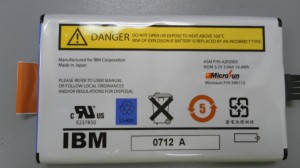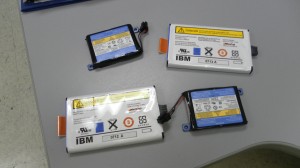Over the weekend, I worked with IBM to change the disk cache batteries on one of our Power 7 720 CBU machines running IBM i 6.1.
When the cache batteries on a Power 7 box get within 90 days of their expected end of life, the i operating system starts issuing alerts for battery replacement. You then have (roughly) 90 days to work with IBM to get the batteries replaced.
If you don’t replace the batteries before they run down, your disk drive performance will significantly degrade because the batteries are powering your disk drive cache.
The trick is to schedule cache battery replacement during a slow processing period because the replacement batteries are not charged when they are installed. IBM delivers uncharged batteries for safety reasons and regulatory requirements (mostly fear of explosion).
This means that your IBM i disk cache will not be powered up when replacing old cache batteries. You’ll essentially be running without disk caching for several hours until the new batteries are charged while in the machine. Once the batteries are charged, disk caching will resume and you’ll see your system speed return to normal. In our case, that took 2-3 hours (YMMV).
I first wrote about the charging issue in 2012 in an IT Jungle article. Since then, I’ve discovered that in certain situations you may not be able to change your batteries concurrently.
For our Power 720 machine, we received four batteries. Two batteries were installed in the back of the CEC and two were installed inside the CEC. The two that were installed at the back of the CEC could be installed concurrently. But to install the batteries inside the CEC required us to open the CEC cover. For a 720 box, this now requires a system shutdown. Check with IBM or your CE to see if you need to power down your box for battery replacement.

This is the cache battery that has to be installed in the CEC, which may force you to bring down the machine during a battery replacement
Read this article to see why you may need to power down your system to open the CEC cover.
So expect two sets of processing delays when changing cache batteries. One if you have to power down your box for installing batteries in the CEC. And a second delay while the batteries themselves charge after installation.







